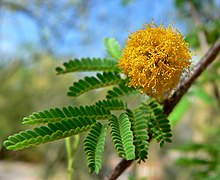
Back Vachellia Afrikaans كنهبل Arabic كنهبل ARZ Vachellia Azerbaijani Vachellia Catalan Vachellia CEB Gɔtia DAG Vachellia Spanish خاردرخت Persian Palloakaasiat Finnish
| Vachellia | |
|---|---|

| |
| Vachellia farnesiana | |
| Scientific classification | |
| Kingdom: | Plantae |
| Clade: | Tracheophytes |
| Clade: | Angiosperms |
| Clade: | Eudicots |
| Clade: | Rosids |
| Order: | Fabales |
| Family: | Fabaceae |
| Subfamily: | Caesalpinioideae |
| Clade: | Mimosoid clade |
| Genus: | Vachellia Wight & Arn. |
| Type species | |
| Vachellia farnesiana (L.) Wight & Arn.
| |
| Species | |
|
147; see text. | |

| |
| The original range of the genus Vachellia. Today it is also found in most Mediterranean countries. | |
| Synonyms[1] | |
| |
Vachellia is a genus of flowering plants in the legume family, Fabaceae, commonly known as thorn trees or acacias. It belongs to the subfamily Mimosoideae. Its species were considered members of genus Acacia until 2009.[2][3] Vachellia can be distinguished from other acacias by its capitate inflorescences and spinescent stipules.[4] Before discovery of the New World, Europeans in the Mediterranean region were familiar with several species of Vachellia, which they knew as sources of medicine, and had names for them that they inherited from the Greeks and Romans[clarification needed].[5]
The wide-ranging genus occurs in a variety of open, tropical to subtropical habitats, and is locally dominant.[6] In parts of Africa, Vachellia species are shaped progressively by grazing animals of increasing size and height, such as gazelle, gerenuk, and giraffe. The genus in Africa has thus developed thorns in defence against such herbivory [clarification needed].[7]
- ^ Maslin, B. R.; Orchard, A. E.; West, J. G. "Nomenclatural and classification history of Acacia (Leguminosae: Mimosoideae), and the implications of generic subdivision" (PDF). worldwidewattle.com. Retrieved 5 November 2015.
- ^ Cite error: The named reference
Kyalangalilwawas invoked but never defined (see the help page). - ^ Cite error: The named reference
Clarkewas invoked but never defined (see the help page). - ^ Dyer C. (2014). "New names for the African Acacia species in Vachellia and Senegalia". Southern Forests: A Journal of Forest Science. 76 (4): iii. doi:10.2989/20702620.2014.980090.
- ^ Austin, Daniel F. (2004). Florida ethnobotany Fairchild Tropical Garden, Coral Gables, Florida, Arizona-Sonora Desert Museum, Tucson, Arizona: with more than 500 species illustrated by Penelope N. Honychurch ... [et al.] Boca Raton, FL: CRC Press. pp. 58–59. ISBN 9780203491881.
- ^ Shorrocks, Bryan; Bates, William (2014). The Biology of African Savannahs (Biology of Habitats Series ed.). Oxford University Press. pp. 231–233. ISBN 978-0198702702.
- ^ Chidumayo, Emmanuel N.; Gumbo, Davison J. (2010). The Dry Forests and Woodlands of Africa: Managing for Products and Services. Routledge. p. 25. ISBN 9781136531378.